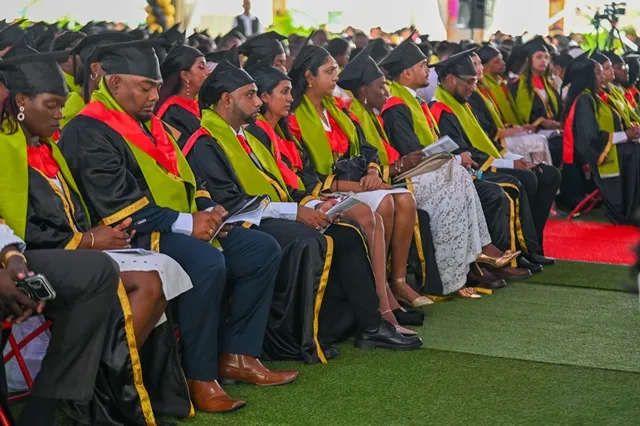Introduction
Guyana is often described as the land of many waters and endless forests – a country where over 85% of the territory is cloaked in lush rainforest. Now, as it undergoes an economic transformation driven by oil, Guyana faces a defining question: can it achieve prosperity without sacrificing its natural heritage? The challenge of environmental sustainability looms large. On one hand, the nation is a global environmental leader – one of only a handful of countries with High Forest, Low Deforestation (HFLD) status, and home to rich biodiversity including giant otters, jaguars, and enormous tropical rivers. On the other hand, increased industrial activity, resource extraction, and climate change impacts threaten ecosystems. In this article, we explore Guyana’s efforts to protect the environment amid development. We examine policies under the Low Carbon Development Strategy, initiatives to preserve forests and wildlife, measures to address climate change and pollution, and how communities (especially Indigenous peoples) are being empowered as environmental stewards. The story of Guyana’s future is not just one of oil wealth, but also of its “green wealth” – the priceless forests, waters, and biodiversity that must be conserved for generations to come.
A Carbon Sink and Biodiversity Haven
Guyana’s environmental credentials are impressive. With 85% forest cover, it has the second-highest percentage of intact forest on Earth, storing an estimated 19.5 billion tons of CO₂ in its biomass. For over a decade, deforestation rates have been among the lowest in the world – just around 0.05% per year on average. In 2022, the deforestation rate was a mere 0.036%, effectively near zero compared to the rampant deforestation seen in many tropical countries. This makes Guyana a vital carbon sink in the fight against climate change. The country’s vast forests are also part of the Guiana Shield, one of the world’s last pristine rainforest frontiers, teeming with endemic species. Wildlife surveys show over 8,000 plant species, 225 mammals, 800+ bird species, and countless insects and aquatic life thrive in these ecosystems. Iconic creatures such as the jaguar, harpy eagle, giant anteater, and arapaima fish call Guyana home, alongside Amerindian communities that have lived symbiotically with nature for millennia.
This natural abundance is sometimes described as Guyana’s “other gold” – just as valuable as the shiny metal or black oil under the ground. Recognizing this, Guyana charted an innovative path back in 2009 with its original Low Carbon Development Strategy (LCDS) under then-President Bharrat Jagdeo. That strategy posited that Guyana could earn economic value by preserving forests (through carbon credits and ecosystem services) rather than cutting them down. Fast forward to today: the updated LCDS 2030 is in full swing, aiming to align the booming oil economy with climate and environmental leadership. Under LCDS, Guyana commits to keep deforestation minimal and use proceeds from forest carbon for sustainable development projects.
One groundbreaking achievement is the recent carbon credit deal with Hess Corporation. In 2022, Guyana became the first country to sell jurisdiction-scale REDD+ carbon credits under the Architecture for REDD+ Transactions (ART) TREES standard. Hess agreed to purchase 37.5 million tons of CO₂ credits for US$750 million (through 2030) This essentially monetizes Guyana’s avoided deforestation – rewarding the country for keeping forests intact. Importantly, a large portion of these funds is earmarked for Indigenous communities and conservation. In 2024, US$4.7 billion Guyanese dollars (around US$22 million) was allocated to 254 Amerindian villages from carbon proceeds to finance their development priorities. This ranges from solar electrification to eco-tourism initiatives managed by those communities. It’s a model of how carbon markets can directly benefit local people who are the frontline guardians of the forest.
Guyana also made history by issuing the world’s first carbon credits for the global aviation offset scheme (CORSIA). Essentially, airlines can now buy Guyana’s credits to offset their emissions – a notable first that cements Guyana’s role as a climate services provider. All these moves underscore that Guyana is striving to turn its conservation value into concrete economic value, thereby creating an incentive to maintain its status as a green sanctuary.

Low Carbon Development Strategy 2030: Ambition and Action
At the heart of Guyana’s environmental policy is the LCDS 2030, a comprehensive plan that weaves together climate action, ecosystem protection, and low-carbon growth sectors. The LCDS has multiple pillars:
- Forests and Carbon Services: Preserve the forests and earn from carbon credits (as described above). Guyana’s approach here has been lauded by the IMF as pioneering. The country essentially asks: why shouldn’t we be paid for the global climate service our forests provide by absorbing carbon? Through partnerships (like one with Norway earlier, and now with ART and private buyers), Guyana is realizing that value.
- Clean Energy Transition: Though now an oil producer, Guyana aims to transition its domestic energy mix to renewables and cleaner sources. The flagship here is the Gas-to-Energy project – a pipeline bringing natural gas from offshore wells to shore by 2025, which will fuel a new 300 MW power plant. This will cut electricity costs by 50% and replace heavy fuel oil for power generation. That means less pollution and greenhouse emissions from current diesel generators. Moreover, Guyana is investing in solar, hydro, and wind. Under LCDS, dozens of solar farms are being installed in towns and villages. Already, 1.5 MW solar farms are up in hinterland towns like Bartica (Region 7) and Lethem (Region 9), and over 26,000 solar home systems were distributed in 2023 alone to off-grid communities. Two small hydropower plants (Kumu 1.5MW and rehabilitating Moco Moco 0.7MW in Region 9) are underway, and the big 165 MW Amaila Falls hydro project is being revisited to drastically boost renewable capacity. By 2030, Guyana targets 70% of its energy to be renewable – an ambitious figure for a country that is ironically now an oil exporter.
- Protected Areas and Biodiversity: The LCDS supports expanding protected areas. Guyana already has several notable protected areas, like Kaieteur National Park (protecting the famous Kaieteur Falls and surrounding rainforest) and Iwokrama rainforest reserve (371,000 hectares co-managed with indigenous Makushi people). Additional areas in the pipeline include wetlands along the coast and savannah ecosystems in the south. The goal is to safeguard representative samples of all major ecosystems. This also ties into promoting eco-tourism as a sustainable industry – marketing Guyana’s unspoiled nature to adventurous travelers. In 2023, Guyana won the “Best in Ecotourism” award at the Sustainable Tourism Conference, reflecting its growing reputation as a green destination.
-  Climate Adaptation: Being a low-lying coastal state, Guyana is acutely vulnerable to climate change, especially rising sea levels and extreme rainfall. The capital, Georgetown, lies largely below sea level and is protected by a seawall built since colonial times. The LCDS allocates significant investment to climate resilience infrastructure – upgrading sea defenses, building better drainage, and implementing water management systems. In recent budgets, tens of billions of Guyanese dollars have been spent on sea wall reinforcement and pumps. A noteworthy project is the construction of the Hope Canal (completed 2015) and additional similar canals which help channel floodwaters from the coastal plain to the Atlantic, preventing the catastrophic floods that historically devastated agriculture. Further, Guyana is exploring nature-based adaptation like restoring mangrove forests along the coast, which act as buffers against storm surges. Mangroves also sequester carbon and nurture fisheries – a win-win for environment and economy. The government has replanted hundreds of acres of mangroves in recent years after some loss in the 2010s.

Balancing Oil and Environment
Guyana’s unique situation – simultaneously pushing fossil fuel extraction and climate leadership – raises eyebrows in some quarters. There is an inherent tension: oil production leads to emissions (mostly when the oil is eventually burned elsewhere, but also through local flaring and operations), potentially undermining global climate goals. President Ali and VP Jagdeo often address this by framing Guyana’s approach as a pragmatic balance. They argue that Guyana’s net contribution to climate change remains positive: “We are a net carbon sink even with oil, because our forests offset 154 million tons of CO₂ annually, far more than the emissions from our oil production”, officials claim (citing internal analyses). Indeed, with the current scale of oil output, Guyana still likely remains carbon-negative domestically due to its forests. However, that may change as oil scales up unless offsets or carbon capture are increased.
To reconcile this, the government emphasizes using oil revenues to fund the very climate solutions and green economy initiatives in LCDS. Essentially, “using the oil to go green.” For instance, oil money is paying for the solar farms, gas-to-energy (which itself cuts emissions by replacing dirty diesel), and adaptations. Without oil revenue, Guyana would have to rely on loans or aid for such projects. President Ali, at COP27 and other fora, has advocated this balanced approach and called out the inequity that countries like Guyana, which preserved forests while being poor, are now told not to develop their hydrocarbons. He insists that global climate targets must account for differentiated responsibilities – Guyana should not be punished for exploiting oil when it has contributed almost nothing to historical emissions and is in fact offering climate services through its forests.
That said, the government is not ignoring the environmental risks of oil operations. Following a major discovery, one of the first actions was to update oil spill contingency plans and environmental regulations. Exxon’s operations have to adhere to a strict flare minimization rule (flaring of gas offshore is limited and taxed when it occurs). An Environmental Permitting system is in place for all oil-related projects, overseen by the EPA (Environmental Protection Agency) of Guyana. The EPA’s capacity has been bolstered with international help, though critics argue it’s still playing catch-up to properly monitor the booming industry. Civil society has been vigilant too – for example, lawsuits were filed pushing for full liability coverage in case of an oil spill, leading to a High Court ruling that operators must provide adequate financial assurances.
Another area of balancing act is mining and logging. Gold mining is a big traditional sector and also a driver of deforestation and mercury pollution in rivers. Under the LCDS, the government aims to promote more sustainable mining practices – encouraging technologies that don’t use mercury, and requiring reforestation of mined-out areas. The Guyana Geology and Mines Commission now mandates environmental bonds from miners and has stepped up monitoring of illegal mining in protected forests. Logging, which was never at massive scale in Guyana compared to Amazon countries, is being managed via concessions with annual allowable cuts, and more value-added processing is encouraged so fewer trees are cut for raw export. Community Forestry has grown, giving local communities rights to small-scale sustainable logging and income while protecting large tracts from industrial exploitation.
Indigenous Leadership in Conservation
Indigenous peoples (locally referred to as Amerindians, comprising about 10% of the population across nine recognized tribes) are central to Guyana’s environment story. They inhabit vast areas of the interior and have ancestral knowledge of the forests and wildlife. The government has increasingly involved Indigenous communities in conservation initiatives. One successful model is the Kanashen Amerindian Protected Area in the south, Guyana’s first community-owned conservation area, covering 625,000 hectares of largely pristine forest managed by the Wai-Wai people. They receive support and training to patrol and monitor biodiversity, effectively acting as forest rangers for their own land.
Under LCDS 2030, as mentioned, carbon credit funds are being channeled to Amerindian villages. Communities had to craft Village Sustainability Plans outlining how they’ll use funds for development in harmony with the environment. Many chose projects like eco-lodges, agro-forestry, or aquaculture – economic activities that do not destroy the forest. For example, Rewa village in the north Rupununi is expanding its eco-tourism lodge and training wildlife guides; Santa Aratack village closer to the coast is investing in crab farming and craft production. This approach empowers Indigenous people as stakeholders and beneficiaries of conservation. It is both ethically right and practical, since it’s well-documented globally that Indigenous-managed forests often have the lowest deforestation rates.
The government also reconstituted the Indigenous People’s Commission and established an LCDS Indigenous People’s Advisory Group to ensure their voices in climate projects. Land titling for Indigenous communities, which grants them legal ownership of traditional lands, has progressed (though a few disputes remain). Secure land rights are crucial for communities to confidently manage and protect their environment.
Grassroots and NGO Contributions
In addition to government efforts, a number of local NGOs and community groups actively work on environmental protection. Organizations like Conservation International (CI) Guyana, World Wildlife Fund (WWF) Guianas, and the Iwokrama International Centre are key players. Iwokrama, in particular, is a public trust managing a huge rainforest reserve as a living laboratory of sustainable use – they conduct research on forestry, climate, and ecotourism that guides national policy. CI Guyana helped set up Guyana’s first Center for Biodiversity, documenting species and training Guyanese scientists. WWF has been active in marine conservation, helping create a Marine Protected Area along the Shell Beach area (famous for nesting sea turtles) in Region 1.
Community-driven initiatives include the South Rupununi Conservation Society, which protects the critically endangered Red Siskin bird and monitors arapaima fish stocks with Indigenous fisherfolk. In the North Rupununi, a network of villages operates a wetland management program for the vast flooded savannas, keeping them healthy for wildlife and sustainable fishing. These grassroots actions complement national policies and often pilot new ideas that can be scaled up.
One example is the restoration of Giant River Otter populations. These otters were declining due to habitat loss and hunting. A community education campaign by an NGO in Region 9, together with making the otter a sort of eco-tourism mascot, led to local fishermen protecting the species. Now the Rupununi River has one of the largest Giant Otter populations in the world, a conservation success attributed to local buy-in.

Challenges Ahead
Despite an admirable trajectory, Guyana’s environmental stewardship is not without challenges. As oil wealth pours in, there is internal pressure for rapid infrastructure expansion – new roads, bridges, and industrial development that could encroach on wilderness. For instance, the government is contemplating a road through the southern rainforest to Brazil which, while boosting trade, could bring deforestation and illegal activities unless very carefully managed (a similar dynamic observed when the BR-163 highway opened in the Brazilian Amazon). Environmentalists urge rigorous impact assessments and mitigation if such projects proceed. The Mongabay news outlet reported conservationists’ concerns about road projects impacting forests and savannas if proper safeguards aren’t in place.
Climate change itself is a major threat. Guyana’s coast could face more extreme floods; the interior could see droughts that spark wildfires in savannahs. The country will have to invest continuously in resilience – an expensive endeavor, though oil revenue can help fund it. Another worry is the global market: if carbon credit prices slump or international support wanes, will Guyana still find it financially attractive to keep trees standing vs. say, expanding agriculture? The government is trying to hedge by securing long-term carbon deals and mainstreaming green economic activities (like eco-tourism, sustainable agriculture) that make forests worth more alive than dead.
Pollution control is an ongoing battle. Gold mining’s mercury use, if not eliminated, can poison rivers for decades. Solid waste management in urban areas is also problematic – Georgetown struggles with garbage that clogs drains and ends up in waterways. The administration has launched a “Clean Green Guyana” campaign to improve waste disposal and ban single-use plastics (a ban is planned to take effect in coming years). Ensuring effective enforcement of these environmental regulations will test the capacity of agencies.
Lastly, continued public awareness and education are vital. The younger generation must be brought into the cause of conservation even as they enjoy new economic prospects. Encouragingly, environmental science is now part of the school curriculum and youth groups like the Guyana Marine Conservation Society are active. The narrative that Guyana can be both the next Dubai (in wealth) and the next Amazon (in conservation) is a bold one, but it resonates with many proud of their country’s natural beauty.
Conclusion
Guyana’s story is a rarity: a nation trying to lead on climate and environment while undergoing fast development. So far, it has shown that these need not be mutually exclusive. With initiatives like the LCDS, innovative carbon financing, strong forest protection, and community-led conservation, Guyana is “walking the talk” on sustainable development. It has earned international praise – the IMF hailed Guyana as a “global leader in climate policies”, and the country’s model is being studied as a template for others. There will be tough choices ahead, especially as oil revenue tempts large-scale industrialization. But if Guyana stays true to its green vision, it can indeed be a model for how a small state can chart a development path that values nature as much as GDP.
For Guyanese people, the environment is more than just trees or animals – it is part of their cultural identity and survival. From the fisheries that provide protein to coastal villages, to the forests that safeguard indigenous traditions and offer eco-tourism jobs, nature and livelihoods are intertwined. As the nation moves forward, the hope is that “green growth” isn’t just a buzzword but a lived reality: cleaner energy, resilient communities, protected forests, and thriving biodiversity alongside modern infrastructure and improved living standards. The guardians of Guyana – be they policymakers, indigenous elders, scientists, or youths – are collectively tasked with ensuring that the country’s future is not only prosperous but also sustainable and green. The world is watching closely, and rooting for Guyana to succeed in this delicate balancing act.




